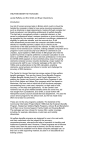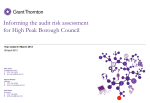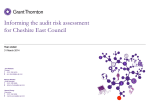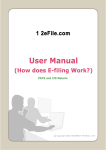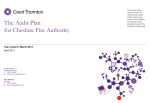Download The Audit Plan – template user guide
Transcript
AGENDA ITEM NO 6 Informing the Audit Risk Assessment South Staffordshire Council Year ended 31 March 2015 February 2015 Mark Stocks Director T 0121 232 5437 E [email protected] Emily Mayne Audit Manager T 0121 232 5309 E [email protected] Tom Joy Associate T 0121 232 5179 E [email protected] © 2015 Grant Thornton UK LLP | Informing the Audit Risk Assessment | February 2015 Contents Section Page Purpose 3 Fraud 4 Fraud Risk Assessment 5 Laws and Regulations 7 Impact of Laws and Regulations 8 Going Concern 10 Going Concern Consideration 11 Related Parties 13 Related Parties Assessment 14 Accounting Estimates 15 Appendix 1: Accounting Estimates 16 The contents of this report relate only to the matters which have come to our attention, which we believe need to be reported to you as part of our audit process. It is not a comprehensive record of all the relevant matters, which may be subject to change, and in particular we cannot be held responsible to you for reporting all of the risks which may affect your business or any weaknesses in your internal controls. This report has been prepared solely for your benefit and should not be quoted in whole or in part without our prior written consent. We do not accept any responsibility for any loss occasioned to any third party acting, or refraining from acting on the basis of the content of this report, as this report was not prepared for, nor intended for, any other purpose. © 2015 Grant Thornton UK LLP | Informing the Audit Risk Assessment | February 2015 . 2 Purpose The purpose of this report is to contribute towards the effective two-way communication between auditors and the Council's Audit Committee, as 'those charged with governance'. The report covers some important areas of the auditor risk assessment where we are required to make inquiries of the Audit Committee under auditing standards. Background Under International Standards on Auditing (UK and Ireland) (ISA(UK&I)) auditors have specific responsibilities to communicate with the Audit Committee. ISA(UK&I) emphasise the importance of two-way communication between the auditor and the Audit Committee and also specify matters that should be communicated. This two-way communication assists both the auditor and the Audit Committee in understanding matters relating to the audit and developing a constructive working relationship. It also enables the auditor to obtain information relevant to the audit from the Audit Committee and supports the Audit Committee in fulfilling its responsibilities in relation to the financial reporting process. Communication As part of our risk assessment procedures we are required to obtain an understanding of management processes and the Audit Committee's oversight of the following areas: • Fraud • Laws and Regulations • Going Concern • Related parties • Accounting estimates This report includes a series of questions on each of these areas and the response we have received from the Council's management. We ask the Audit Committee to consider whether these responses are consistent with the its understanding and whether there are any further comments it wishes to make. © 2015 Grant Thornton UK LLP | Informing the Audit Risk Assessment | February 2015 3 Fraud Issue Matters in relation to fraud ISA(UK&I)240 covers auditors responsibilities relating to fraud in an audit of financial statements. The primary responsibility to prevent and detect fraud rests with both the Audit Committee and management. Management, with the oversight of the Audit Committee, needs to ensure a strong emphasis on fraud prevention and deterrence and encourage a culture of honest and ethical behaviour. As part of its oversight, the Audit Committee should consider the potential for override of controls and inappropriate influence over the financial reporting process. As auditor, we are responsible for obtaining reasonable assurance that the financial statements are free from material misstatement due to fraud or error. We are required to maintain professional scepticism throughout the audit, considering the potential for management override of controls. As part of our audit risk assessment procedures we are required to consider risks of fraud. This includes considering the arrangements management has put in place with regard to fraud risks including: • • • • assessment that the financial statements could be materially misstated due to fraud process for identifying and responding to risks of fraud, including any identified specific risks communication with the Audit Committee regarding its processes for identifying and responding to risks of fraud communication to employees regarding business practices and ethical behaviour. We need to understand how the Audit Committee oversees the above processes. We are also required to make inquiries of both management and the Audit Committee as to their knowledge of any actual, suspected or alleged fraud. These areas have been set out in the fraud risk assessment questions below together with responses from the Council's management. © 2015 Grant Thornton UK LLP | Informing the Audit Risk Assessment | February 2015 4 Fraud risk assessment Question Management response Has the Council assessed the risk of material misstatement in the financial statements due to fraud? What are the results of this process? Although there is an on-going risk of fraud being committed against the Council, arrangements are in place to both prevent and detect fraud. These include work carried out by Internal Audit on overall fraud risk areas, on Council Tax and Housing Benefit fraud. Fraud is identified as a "red" risk in the Council's Operational Risk register due to likelihood of some fraud occurring and the potential adverse publicity which fraud could create. However, the risk of material misstatement of the accounts due to undetected fraud is considered to be low. What processes does the Council have in place to identify and respond to risks of fraud? The Council has a Counter Fraud and Corruption Policy and Strategy in place. This is also supported by a Whistleblowing Policy which includes a confidential reporting framework. Fraud can also be reported through the Council's website by external parties. Internal Audit include fraud risks in their planning process and act as an effective internal control against fraud. Regular reports are made to Audit Committee. Have any specific fraud risks, or areas with a high risk of fraud, been identified and what has been done to mitigate these risks? Evidence published by the National Fraud Authority amongst others, suggests that fraud is committed in all organisations to varying degrees, so it is likely that some fraud is occurring at South Staffordshire Council. As noted above, there are some areas that are inherently at risk from fraud such as: • Council Tax • Benefit fraud • Single person discount. The Council's dedicated benefits fraud team undertake investigations of suspected benefit fraud cases. The Internal Audit plan incorporates consideration of potential fraud. In addition to this management is expected to identify and record fraud risks where necessary on the corporate risk register. Are internal controls, including segregation of duties, in place and operating effectively? If not, where are the risk areas and what mitigating actions have been taken? Yes – there is an adequate process in place for reviewing the system of internal control via the work of Internal Audit. Internal Audit include fraud risks in their planning process and act as an effective internal control against fraud. © 2015 Grant Thornton UK LLP | Informing the Audit Risk Assessment | February 2015 5 Fraud risk assessment Question Management response Are there any areas where there is a potential for override of controls or inappropriate influence over the financial reporting process (for example because of undue pressure to achieve financial targets)? Are there any areas where there is a potential for misreporting override of controls or inappropriate influence over the financial reporting process? How does the Audit Committee exercise oversight over management's processes for identifying and responding to risks of fraud? What arrangements are in place to report fraud issues and risks to the Audit Committee? Internal Audit provide the Audit Committee with updates of their work on fraud prevention and detection, including any significant identified frauds and the action taken. The Audit Committee also receive reports on the work of the Council's Benefits Fraud team, including details of the levels of fraud identified and action taken as a result. How does the Council communicate and encourage ethical behaviour of its staff and contractors? There is a staff code of conduct and Financial Regulations. Staff are regularly reminded of these. How do you encourage staff to report their concerns about fraud? Have any significant issues been reported? There is a Counter Fraud and Corruption Policy and Strategy and a Whistleblowing procedure in place which explain the procedures to follow. No significant issues have been reported, nor have any issues been reported under the Bribery Act. Are you aware of any related party relationships or transactions that could give rise to risks of fraud? 2013/14 financial statement disclosure of related party transactions does not identify potential fraud risk. Members and officers are required to make full disclosure of any relationships that impact on their roles. Members are required to declare any relevant interests at Council and Committee meetings. Are you aware of any instances of actual, suspected or alleged, fraud, either within the Council as a whole or within specific departments since 1 April 2014? There are no material instances of fraud that have been identified during the year. There are some areas that are inherently at risk from fraud such as: • Council Tax • Benefit fraud • Single person discount. The Council's dedicated benefits fraud team undertakes investigations of suspected benefit fraud cases. © 2015 Grant Thornton UK LLP | Informing the Audit Risk Assessment | February 2015 None known. Head of Internal Audit Opinion in 2013/14 did not highlight any weaknesses in this area. None known. Head of Internal Audit Opinion in 2013/14 did not highlight any weaknesses in this area. 6 Laws and regulations Issue Matters in relation to laws and regulations ISA(UK&I)250 requires us to consider the impact of laws and regulations in an audit of the financial statements. Management, with the oversight of the Audit Committee, is responsible for ensuring that the Council's operations are conducted in accordance with laws and regulations including those that determine amounts in the financial statements. As auditor, we are responsible for obtaining reasonable assurance that the financial statements are free from material misstatement due to fraud or error, taking into account the appropriate legal and regulatory framework. As part of our risk assessment procedures we are required to make inquiries of management and the Audit Committee as to whether the entity is in compliance with laws and regulations. Where we become aware of information of non-compliance or suspected non-compliance we need to gain an understanding of the noncompliance and the possible effect on the financial statements. Risk assessment questions have been set out below together with responses from management. © 2015 Grant Thornton UK LLP | Informing the Audit Risk Assessment | February 2015 7 Impact of Laws and Regulations Question Management response What arrangements does the Council have in place to prevent and detect non-compliance with laws and regulations? The Monitoring Officer is responsible for ensuring the Council is compliant with laws and regulations. These responsibilities cover: • complying with the law of the land (including any relevant Codes of Conduct); • complying with any General Guidance issued, from time to time, by the Standards Committee and / or advice of the Monitoring Officer; • making lawful and proportionate decisions; and • generally, not taking action that would bring the Council, their offices or professions into disrepute. This officer has access to all Council committee reports. Monitoring Officer raises awareness on legal requirements at meeting where needed. In addition in terms of any specific legal issues the Monitoring Officer would get involved at an early stage. Further information on how the Monitoring Officer carries out these responsibilities are detailed in the Constitution. The Section 151 officer is responsible for preparing the accounting statements in accordance with relevant legal and regulatory requirements. How does management gain assurance that all relevant laws and regulations have been complied with? See response above How is the Audit Committee provided with assurance that all relevant laws and regulations have been complied with? The Monitoring Officer attends Audit Committee meetings and advises members on any areas of concern. Have there been any instances of non-compliance or suspected non-compliance with law and regulation since 1 April 2014, or earlier with an on-going impact on the 2014/15 financial statements? What arrangements does the Council have in place to identify, evaluate and account for litigation or claims? None noted. © 2015 Grant Thornton UK LLP | Informing the Audit Risk Assessment | February 2015 The Monitoring Officer and Section 151 Officer identify and evaluate the impact of litigation and claims which are then recorded as expenditure as a provision or disclosed as a contingent liability in the financial statements. 8 Impact of Laws and Regulations Question Management response Is there any actual or potential litigation or claims that would affect the financial statements? None noted Have there been any reports from other regulatory bodies, such as HM Revenues and Customs which indicate noncompliance? None noted. © 2015 Grant Thornton UK LLP | Informing the Audit Risk Assessment | February 2015 9 Going concern Issue Matters in relation to going concern ISA(UK&I)570 covers auditor responsibilities in the audit of financial statements relating to management's use of the going concern assumption in the financial statements. The going concern assumption is a fundamental principle in the preparation of financial statements. Under this assumption entities are viewed as continuing in business for the foreseeable future. Assets and liabilities are recorded on the basis that the entity will be able to realise its assets and discharge its liabilities in the normal course of business. The code of practice on local authority accounting requires an authority’s financial statements to be prepared on a going concern basis. Although the Council is not subject to the same future trading uncertainties as private sector entities, consideration of the key features of the going concern provides an indication of the Council's financial resilience. As auditor, we are responsible for considering the appropriateness of use of the going concern assumption in preparing the financial statements and to consider whether there are material uncertainties about the Council's ability to continue as a going concern that need to be disclosed in the financial statements. We discuss the going concern assumption with management and review the Council's financial and operating performance. Going concern considerations have been set out below and management has provided its response. © 2015 Grant Thornton UK LLP | Informing the Audit Risk Assessment | February 2015 10 Going concern considerations Question Management response Does the Council have procedures in place to assess the Council's ability to continue as a going concern? The Council's latest Medium Term Financial Strategy indicates a balanced position to 2018/19. This, as well as the in year budget (2014/15) reflects government changes in terms of grant settlement and the financial settlement. The 2015/16 budgets were agreed on 24th February 2015. Is management aware of the existence of other events or conditions that may cast doubt on the Council's ability to continue as a going concern? The Council has developed and approved a 2015/16 Budget and a Medium Term Financial Strategy which set out the financial challenges facing the Council in the short to medium term and the action necessary to ensure that the Council is able to continue to deliver a balanced financial position. Are arrangements in place to report the going concern assessment to the Audit Committee? The Chief Finance Officer has presented details of the 2015/16 budget and underlying assumptions to members. No significant issues raised which cast doubt on the assumptions made. Members recognise that the Council is facing a challenging financial position in the medium term, however in the short term the level of accumulated reserves is sufficient to ensure the delivery of priorities. Are the financial assumptions (eg future levels of income and expenditure) consistent with the Council's Business Plan and the financial information provided to the Council throughout the year? The Medium Term Financial Strategy sets out detailed assumptions and makes clear reference to the Council Plan as the basis for the financial considerations in setting the medium term budget. The Financial Plan has been prepared by appropriately qualified and experienced staff in consultation with Department Managers. It has also been considered by the Overview and Scrutiny Committee. The financial assumptions are therefore consistent with the Council Plan. Reporting in year has been consistent with the 2015/16 budget set. Are the implications of statutory or policy changes appropriately reflected in the Business Plan, financial forecasts and report on going concern? The Council's latest Medium Term Financial Strategy and 2015/16 Budgets reflect government changes in terms of the grant settlement and the financial settlement. © 2015 Grant Thornton UK LLP | Informing the Audit Risk Assessment | February 2015 11 Going concern considerations Question Management response Have there been any significant issues raised with the Audit Committee during the year which could cast doubts on the assumptions made? (Examples include adverse comments raised by internal and external audit regarding financial performance or significant weaknesses in systems of financial control). Does a review of available financial information identify any adverse financial indicators including negative cash flow? If so, what action is being taken to improve financial performance? The Chief Finance Officer has presented details of the 2015/16 budget and underlying assumptions to members. No significant issues raised which cast doubt on the assumptions made. Members recognise that the Council is facing a challenging financial position in the medium term, however in the short term the level of accumulated reserves is sufficient to ensure delivery of priorities. Does the Council have sufficient staff in post, with the appropriate skills and experience, particularly at senior manager level, to ensure the delivery of the Council’s objectives? If not, what action is being taken to obtain those skills? Consider that the Council has the appropriate skills and expertise within its Senior Management Team to enable it to address the financial challenges faced in the medium term. Succession planning is in place for any changes planned for 2015/16. © 2015 Grant Thornton UK LLP | Informing the Audit Risk Assessment | February 2015 Review of the latest detailed financial information presented to Council members (as at February 2015) did not highlight any adverse financial indicators which required specific action. 12 Related Parties Issue Matters in relation to Related Parties For local government bodies the Code of Practice on Local Authority Accounting in the United Kingdom (the Code) requires compliance with IAS24: related party disclosures. The Code identifies the following as related parties: • Subsidiaries; • Associates; • Joint ventures; • An entity that has an interest in the authority that gives it significant influence; • Key management personnel and close family members; and • Pension fund for the benefit of employees. A disclosure is required if a transaction (or series of transactions) is material on either side, i.e. if a transaction is immaterial from the Council's perspective but material from a related party viewpoint then the Council must disclose it. ISA (UK&I) 550 requires us to review your procedures for identifying related party transactions and obtain an understanding of the controls that you have established to identify such transactions. I will also carry out testing to ensure the related party transaction disclosures you make in the financial statements are complete and accurate. © 2015 Grant Thornton UK LLP | Informing the Audit Risk Assessment | February 2015 13 Related Parties Assessment Question Management response Who are the Council's related parties? The Council has a number of related parties in which there is a material impact to the financial statements via virtue of whether the Council might have: • the potential either to be controlled or influenced by the party or • the potential to exert control or influence over the party (as defined by guidance in the Code). The Council discloses its related parties under the following headings: 1. Government - central government has control influence over the Council as the Council needs to act in accordance with its statutory responsibilities. 2. Pension Fund - this party is subject to common control by central government. 3. Precepts & Levies - these parties are subject to common control by central government and thus might be empowered to transact on non-commercial terms. The Council is bound to pay the amount demanded from these parties through precept or levy. 4. Assisted Organisations - the provision of financial assistance by the Council to such parties or voluntary organisations may give the Council influence on how the funds are to be administered and applied. 5. Members and Officers - Certain Members and Officers may have controlling influence or related interests with other of the Council's related party organisations, such that they may be in a position to significantly influence the policies of the Council. In 2013/14 such related parties were: • Citizens Advice Bureau • Cheslyn Hay Sport & Community School • Wolgarston High School • Ounsdale High School What are the controls in place to identify, account for, and disclose, related party transactions and relationships? A number of arrangements are in place for identifying the nature of a related party and reported value including: • Maintenance of a Register of interests for Members, a register for pecuniary interests in contracts for Officers and Senior Managers requiring disclosure of related party transactions. • Annual return from senior managers/officers requiring confirmation that they have read and understood the declaration requirements and stating details of any known related party interests. • Review of in-year income and expenditure transactions with known identified related parties from prior year or known history. • Review of related information with subsidiaries, companies and joint ventures, e.g. accounts. • Review of the accounts payable system and identification of amounts paid to assisted or voluntary organisations. © 2015 Grant Thornton UK LLP | Informing the Audit Risk Assessment | February 2015 14 Accounting Estimates Issue Matters in relation to Accounting Estimates Local authorities need to apply appropriate estimates in the preparation of their financial statements. ISA (UK&I) 540 sets out requirements for auditing accounting estimates. The objective is to gain evidence that the accounting estimates are reasonable and the related disclosures are adequate. Under this standard we have to identify and assess the risks of material misstatement for accounting estimates by understanding how the Council identifies the transactions, events and conditions that may give rise to the need for an accounting estimate. Accounting estimates are used when it is not possible to measure precisely a figure in the accounts. We need to be aware of all estimates that the Council is using as part of its accounts preparation; these are detailed in appendix 1 to this report. The audit procedures we conduct on the accounting estimate will demonstrate that: • the estimate is reasonable; and • estimates have been calculated consistently with other accounting estimates within the financial statements. © 2015 Grant Thornton UK LLP | Informing the Audit Risk Assessment | February 2015 15 Appendix 1: Accounting Estimates Estimate Method / model used to make the estimate Controls used to identify estimates Whether Management have used an expert Underlying assumptions: - Assessment of degree of uncertainty - Consideration of alternative estimates Valuation of property plant and equipment Valuations are made by the appointed Valuer (Wilkes, Head and Eve Chartered Surveyors and Town Planners) in line with RICS guidance on the basis of 5 year valuations with interim reviews. Capital Accountant notifies the Valuer of the program of rolling valuations or of any conditions that warrant an interim re-valuation. Valuer used for PPE valuations. Valuations are made inline with RICS guidance reliance on expert. Depreciation of property plant and equipment The following asset categories have general asset lives: Consistent asset lives applied to each asset category. Valuer used for PPE and estimated remaining useful life assessments. The method makes some generalisations. For example, buildings tend to have a useful life of 50 years. Although in specific examples based upon a valuation review, a new building can have a life as short as 25 years or as long. as 70 years depending on the construction materials used. This life would be recorded in accordance with the local qualified RICS or CIB Member. • Buildings 50 years • Equipment/vehicles 5 years • Plant 12 years • Infrastructure 40 years. Depreciation is provided for all fixed assets with a finite life on a straight line basis. Asset lives for buildings are obtained from the Valuer. © 2015 Grant Thornton UK LLP | Informing the Audit Risk Assessment | February 2015 Has there been a change in accountin g method in-year? No No 16 Appendix 1: Accounting Estimates Estimate Method / model used to make the estimate Controls used to identify estimates Whether Management have used an expert Underlying assumptions: - Assessment of degree of uncertainty - Consideration of alternative estimates Impairment of property plant and equipment Assets are assessed at each year-end as to whether there is any indication that an asset may be impaired. Where indications exist and any possible differences are estimated to be material, the recoverable amount of the asset is estimated and, where this is less than the carrying amount of the asset, an impairment loss is recognised for the shortfall. Assets are assessed at each year-end as to whether there is any indication that an asset may be impaired. Provision for irrecoverable debts A provision is estimated using a proportion basis of an aged debt listing. Accruals The Finance Team collate accruals of income and expenditure from sales ledger, purchase ledger and budget information. Activity is accounted for in the financial year that it takes place, not when the money is paid or received in line with the accounting policies. Members of the No finance team calculate the provisions from the aged debt listing based upon prior experience. Sales ledger, No purchase ledger and management accounts information is assessed by the Finance Team. © 2015 Grant Thornton UK LLP | Informing the Audit Risk Assessment | February 2015 Valuer used for PPE valuations. Has there been a change in accounting method inyear? Valuations are made inline with RICS guidance - reliance on expert. No A consistent proportion of the aged debt listing is applied after any specific debts have been provided for where circumstances of certainty are known. The proportion is based upon the type of debt and historic payment pattern. Accruals for income and expenditure have been [principally based on known values. Where estimates have to be made these are based upon the latest available information. No No 17 Appendix 1: Accounting Estimates Estimate Method / model used to make the estimate Controls used to identify estimates Whether Management have used an expert Underlying assumptions: - Assessment of degree of uncertainty - Consideration of alternative estimates Provision for liabilities Provisions are made where an event has taken place that gives the Council a legal or constructive obligation that probably requires settlement. by a transfer of economic benefits or service potential, and a reliable estimate can be made of the value. Provisions are charged as an expense to the appropriate service line in the CIES in the year that the Council becomes aware of the obligation, and are measured at the best estimate at the balance sheet date of the expenditure required to settle the obligation, taking into account relevant risks and uncertainties. Measurement of Financial Instruments The Council values financial instruments at fair value based upon current conditions and Senior Finance team judgement. © 2015 Grant Thornton UK LLP | Informing the Audit Risk Assessment | February 2015 Has there been a change in accounting method inyear? No Charged in the year that the Council becomes aware of the obligation. A calculation is made by the Senior members of the finance team based upon information from third parties, e.g. insurers, solicitors. No Estimated settlements are reviewed at the end of each financial year – where it becomes less than probable that a transfer of economic benefits will now be required (or a lower settlement than anticipated is made), the provision is reversed and credited back to the relevant service. Where some or all of the payment required to settle a provision is expected to be recovered from another party (e.g. from an insurance claim), this is only recognised as income for the relevant service if it is virtually certain that reimbursement will be received by the Council. An estimate is made by Senior members of the finance team. No The Council does not have many No balances which are required to be disclosed as a financial instrument. Considered straight forward with a low degree of estimation required. 18 Appendix 1: Accounting Estimates Estimate Method / model used to make the estimate Controls used to identify estimates Whether Management have used an expert Underlying assumptions: - Assessment of degree of uncertainty - Consideration of alternative estimates Finance leases Fixed assets recognised under finance leases are accounted for using the policies applied generally Property, Plant and Equipment, subject to depreciation being charged over the lease term if this is shorter than the asset's estimated useful life. Pensions – defined benefit pension amounts and disclosures Non adjusting events – events after the Balance Sheet date The Council is an admitted body to the Local Government Pension Scheme. Information is passed from the Council to the Actuary upon which they base their assessment for the financial year end. The Section 151 Officer makes the assessment. If the event is indicative of conditions that arose after the balance sheet date then this is an un-adjusting event. For these events, only a note to the accounts is included identifying the nature of the event and where possible estimates of the financial effect. © 2015 Grant Thornton UK LLP | Informing the Audit Risk Assessment | February 2015 Has there been a change in accounting method inyear? No Finance review contracts and payments to ensure the lease is categorised correctly as a finance lease or operating lease. The Actuary's report is reviewed by Finance Staff for reasonableness. No Accounting entries are based upon schedules setting out the costs over the life of the agreement, based upon the initial lease which is a legally binding document. These are reviewed each year for any changes, but generally are applied over the life of the asset. Yes – the Actuary for Pension Scheme. Reliance upon the expertise of the Actuary of the Pension Scheme. No The Section 151 Officer liaises with the Senior Team and considers all known information in forming her judgement. No, unless the specific un-adjusting event requires additional expertise. This would be considered individually for each case. No 19 © 2015 Grant Thornton UK LLP. All rights reserved. 'Grant Thornton' means Grant Thornton UK LLP, a limited liability partnership. Grant Thornton is a member firm of Grant Thornton International Ltd (Grant Thornton International). References to 'Grant Thornton' are to the brand under which the Grant Thornton member firms operate and refer to one or more member firms, as the context requires. Grant Thornton International and the member firms are not a worldwide partnership. Services are delivered independently by member firms, which are not responsible for the services or activities of one another. Grant Thornton International does not provide services to clients. grant-thornton.co.uk





















